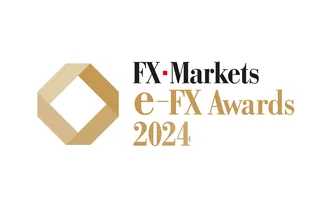
Best Bank Awards: EBS
EBS is voted Best broker for spot FX at the 2019 FX Week Best Bank Awards

A focus on emerging market currencies over the past year – in particular, deliverable USD/CNH, and its Asian currency and non-deliverable forward (NDF) franchise – helped to propel EBS yet again to win the approval of its clients, who voted it the Best broker for spot FX at the 2019 FX Week Best Bank Awards.
According to Jeff Ward, global head of EBS, the venue has focused on “ensuring we have the right sort of business rules, the right tools for clients, a good execution experience on the platform, and we continue to support those markets which have different liquidity dynamics than G10 currency trading”.
Ward points to the Bank for International Settlements’ 2019 triennial survey, which referenced growth in emerging market currencies. As in previous surveys, the currencies of emerging market economies gained market share, reaching 25% of overall global turnover. However, turnover in the renminbi grew only slightly faster than the aggregate market and the Chinese currency did not climb further in the global rankings.
For EBS, between 2016 and 2019, volumes in Asian currency NDFs increased by 138%, while CNH volumes rose 59% over the period. “We definitely see that growth there,” he says.
In October, meanwhile, EBS conducted the first-ever African NDF trade on a central limit order book trading platform. The USD/KES one-month NDF trade was executed between Bank of America and Citi. EBS has also added USD/NGN, USD/ZMW and USD/GHS one-month NDF currency pairs.
Another factor affirming EBS’s approval ratings from clients has been its continuous improvements to its Quant Analytics platform, launched in September 2017. This year, it enabled API access to the tool, meaning banks can pull down data into their own systems and adjust their pricing dynamically as a result.
Ward says: “We have seen this helped the average hold times on our platform. The time it takes for a liquidity provider to respond to trade execution requests dropped by 61% and reject rates fell 41%.”
He explains: “It allows both liquidity consumers and providers to have much deeper insight into the relationship-based trading they’re doing with each other. Liquidity consumers are able to use this data with full transparency to improve their execution experience, and there are benefits for liquidity providers in the overall yield they might get providing pricing to a particular liquidity consumer.”
This will result in greater certainty of execution for takers that are latency sensitive
Jeff Ward, EBS
Last month, the platform also rolled out the ability for liquidity consumers and providers to flag up their adherence to the FX Global Code of Conduct.
Looking forward, the firm is relaunching its quote-driven EBS Direct platform – now live in an early beta – to facilitate improved market data consumption. Round-trip messaging times have a target of sub-50 microseconds.
“This will result in greater certainty of execution for takers that are latency sensitive,” says Ward. “Our initial client testing is confirming that we are making those numbers. Our plans are to roll this out over the next 12-18 months, depending on how long it takes for adoption on the liquidity provider side.”
Increasing volumes
Regarding EBS Institutional, a workflow and trading solution for asset managers, the company is lining up more real-money managers for hedging.
“We had a record day last month and we continue to see increasing volumes on that platform,” says Ward. “We have a good pipeline of clients that have signed up for the service and we’re in the process of onboarding.” However, the workflow requirements of these types of client means there can be long ramp-up times in terms of connectivity and mapping.
Lastly, Ward reports that EBS is making good progress integrating within CME Group, which acquired Nex last year, by migrating its core central limit order book business to CME’s Globex platform – a project aimed for completion by 2021.
“We’re getting very good feedback from clients, in particular those that trade FX-listed products and cash,” he says. “As we integrate these two businesses in terms of liquidity, the services that we can provide to clients open up all kinds of possibilities. We think it’s going to dramatically increase our ability to be more efficient for our clients. It will reduce the number of touch points in trading and introduce the ability to trade through a single user interface, as well as creating opportunities to launch and leverage new products.”
The full list of winners of the 2019 FX Week Best Banks Awards
Only users who have a paid subscription or are part of a corporate subscription are able to print or copy content.
To access these options, along with all other subscription benefits, please contact customer services - www.fx-markets.com/static/contact-us, or view our subscription options here: https://subscriptions.fx-markets.com/subscribe
You are currently unable to print this content. Please contact customer services - www.fx-markets.com/static/contact-us to find out more.
You are currently unable to copy this content. Please contact info@fx-markets.com to find out more.
Copyright Infopro Digital Limited. All rights reserved.
As outlined in our terms and conditions, https://www.infopro-digital.com/terms-and-conditions/subscriptions/ (point 2.4), printing is limited to a single copy.
If you would like to purchase additional rights please email info@fx-markets.com
Copyright Infopro Digital Limited. All rights reserved.
You may share this content using our article tools. As outlined in our terms and conditions, https://www.infopro-digital.com/terms-and-conditions/subscriptions/ (clause 2.4), an Authorised User may only make one copy of the materials for their own personal use. You must also comply with the restrictions in clause 2.5.
If you would like to purchase additional rights please email info@fx-markets.com
More on Awards
J.P. Morgan brings greater transparency to the overlay space
Demand for J.P. Morgan’s FX overlay market services has risen significantly as market participants navigate the hedging and execution complexities of the market
Best prime-of-prime broker: Saxo
With its well-rounded offering and solid balance sheet, Saxo stood out as a trusted liquidity partner, regardless of market conditions
OSTTRA tackles FX risk with new settlement orchestration and expanded optimisation tools
OSTTRA has added settlement orchestration to its suite of FX services to help clients optimise their derivatives portfolios and tackle critical challenges in the market
Best trading technology for FX: smartTrade Technologies
As sell-side market participants more readily accept the integration of machine learning and AI into their processes, smartTrade Technologies unveils advanced services and modules that provide clients with powerful tools to maximise trading efficiency
Best liquidity aggregation service: smartTrade Technologies
With more sophisticated workflows at their fingertips, second-tier market participants are capitalising on smartTrade Technologies’ bespoke services and modules to gain a competitive edge
e-FX awards 2024: The winners
JP Morgan takes home a record five wins, while BNP, DB and NatWest have two each
CME Group bags top awards for FX derivatives and spot
Amid bouts of Apac volatility, market participants tap into CME Group’s deep pools of FX liquidity, seeking certainty in times of economic stress
Best trading platform for retail: OCBC Bank
OCBC diversifies its FX offering with more currencies and 24/7 trading to meet the increasingly sophisticated needs of retail and SME clients







